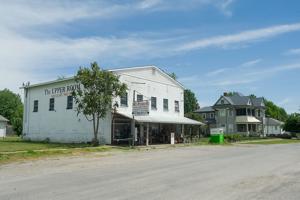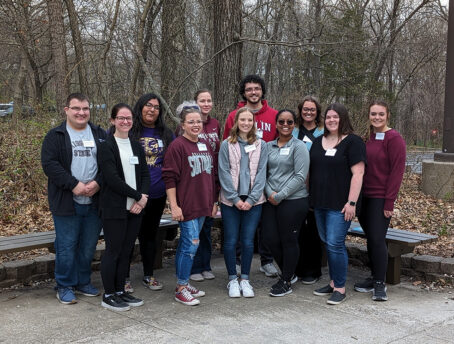Editor's note: Sarah Halasz Graham is the education reporter for The Southern Illinoisan newspaper in Carbondale, Illinois. A graduate of Northwestern University’s Medill School of Journalism, Graham spent her early years in Lanesborough, Massachusetts, a town of 3,091 residents in the heart of the Berkshire Mountains. Though she eventually traded country roads for Chicago’s city lights, Lanesborough holds a piece of her heart. Childhood memories of babbling brooks, horse farms and her close-knit elementary school inspire nostalgia, even 20 years later. Graham felt driven to research the brain drain in Southern Illinois after reading several books on the subject, including “Hollowing Out the Middle: The Rural Brain Drain and What It Means for America,” by sociologists Patrick J. Carr and Maria J. Kefalas.
This article was originally published on June 14, 2015, and is reprinted with the permission of the author and The Southern Illinoisan. Thank you to Sarah and her colleagues for sharing this thoughtful article.
If all goes as planned, at the end of the summer, Kaelyn Watson will be gone.
She’ll be gone from the rolling hills of her home on Mount Moriah Road, where the tall, black refuse piles of the New Era coal mine loom beyond the trees. Gone from the streets of Galatia, the tiny Saline County community that helped raise her. Gone from the halls of her high school, where she learned that she has what it takes to leave.
It’s not that Watson, 18, doesn’t love the small town she’s called home since second grade, the place where street signs bear names of neighbors’ ancestors and “everybody knows everybody” can be a blessing and a curse.
It’s just that in seven years, with her bachelor’s and master’s of science in nursing degrees in hand, she won’t have many options here. There’s no pediatrician’s office in Galatia, let alone the kind of top-notch children’s hospital Watson hopes will hire her.
“It sounds bad, but I don’t want to be held back by this community,” said Watson, who is bound for Southern Illinois University Edwardsville next year. “I know it’s a good community, but at the same time, I’m not going to get the opportunities to do what I want.
“I’m kind of being forced to leave to be able to be successful in the way I want."
This is the rural brain drain. Over the past 35 years, as economic realignments have favored urban technology over rural agriculture, and as well-paying manufacturing jobs have shipped overseas, populations in small towns from West Virginia to Wyoming have stagnated at best and plummeted at worst. And with the jobs have gone the young people — the human capital perhaps best suited to reverse the trend.
It’s a cycle towns and villages across the country have struggled to reverse, the fate of rural America hanging in the balance.
“What’s at stake is the fabric and the diversity that makes America great,” said Patrick Carr, a sociologist at Rutgers University and co-author of “Hollowing Out the Middle: The Rural Brain Drain and What It Means for America.” “Small towns are the heart of America. They’re worth preserving.”
A visit to almost any small-town main street shows the trend has taken its toll. The once-grand early-century brick buildings that used to house pharmacies, grocery stores and banks often stand vacant or don't stand at all, leaving food and service deserts in their stead. Galatia is no exception as can bee seen by this scene in what was the main area of commerce in the town. Photo by Richard Sitler.
Southern Illinois is no stranger to the trend. Only New Jersey outstrips Illinois in terms of net out-migration — the rate at which young people leave the state. In 2012, according to the National Center for Education Statistics, Illinois experienced a net loss of 16,563 students.
And although the brain drain has taken a harsher toll on small communities dotted throughout the Great Plains states, populations from Galatia to Grand Tower have decreased and aged since the 1980 census — and, in some cases, since the Great Depression.
Perched beside the levees of the Mississippi River, the Jackson County village of Grand Tower has lost nearly half its residents since 1940, when 1,043 people called it home. By the 2010 census, the population had dipped to 605.
In Zeigler, Franklin County’s first coal-mine boomtown, the heyday came early. An unofficial census in 1926 measured 5,188 souls, according to historian Allan Patton’s book, “In The Shadow of the Tipple: Zeigler, Illinois.” After decades of steep decline, the population bottomed out in 2000 at 1,669 residents.
A statue honors miners in the center of the downtown circle in Zeigler. Photo by Richard Sitler.
A few towns have fared better. After two decades of decline, Goreville's population has increased since 1990. The Johnson county community registered 1,049 residents in 2010, an 11.8 percent increase from 2000.
Meanwhile, Southern Illinois is aging. In Saline County, the median age jumped from 39.5 to 41.7 between 1980 and 2010. Nationwide, the median hovers at about 37.2.
“It’s a significant issue for us,” said Kathy Lively, CEO of the Marion-based workforce development group Man-Tra-Con. “What we see is that once young people leave here to go away to college, many times they stay gone.”
Kaelyn Watson: Gone Girl
Like most of her out-migrating peers, Watson is one of Galatia’s best and brightest. A self-described overachiever, she scored a 31 on her ACT and maintained a 4.0-plus GPA throughout high school. She stacked her resume with advanced courses, sports and a bevy of acronym-laden extracurriculars — calculus, volleyball, FFA, FBLA, student council, Beta club, and more.
"I get mad if I don't have a good grade," she said. "I've been like that since I was little."
On Aug. 24, she’ll start classes at SIUE on a $4,000 per year scholarship. Aside from working at Dairy Queen in Harrisburg during the summers, she doesn’t intend to return to Southern Illinois.
On a mid-May day, two weeks before she and 26 classmates graduated from Galatia Junior/Senior High School, she sat at her kitchen table after softball practice and described how she pictures her future life.
She’ll nab a job as a pediatric nurse practitioner and live in a city for a while, maybe somewhere in the South, where even on an urban block, people still seem small-town friendly. When it’s time to start a family, she’ll buy a house in the outskirts, on a lot with some land, still close enough to enjoy the city amenities — “the best of both worlds,” as her mom, Crystal Watson, described it.
It’s not always true that the most talented students leave, but when they do, the community feels it that much more.
In 2004, the Southern Illinois Workforce Investment Board released the results of a comprehensive community audit aimed at identifying employment trends and planning a path toward future prosperity.
Kaelyn Watson and her fellow graduates turn their tassles during the Galatia High School Commencement Friday, May 29, 2015. Photo by Richard Sitler.
Researchers found further evidence of a brain drain in a startling statistic: Adults with degrees are the most likely people to leave. The most likely to move in? Those with some or no college experience. (Researchers controlled for SIU’s transient student population.) Man-Tra-Con’s staff oversaw the report. Lively said losing those degreed professionals — and their earning potential — has a “ripple effect” throughout the region.
“For every dollar you don’t spend, it doesn’t get to move around within your economy six or seven times,” she said.
Empty Buildings and Open Hearts
A visit to almost any small-town main street shows the trend has taken its toll. The once-grand early-century brick buildings that used to house pharmacies, grocery stores and banks often stand vacant or don’t stand at all. The rise of the shopping mall and the subsequent shifting of commerce to the outskirts also contributed to widespread downtown downturn.
Galatia’s only doctor closed up shop about seven years ago. Today, one physician’s assistant serves the community. The old feed store is gone now, the building razed. The grocery store shut its doors in about 2003 just after Wal-Mart opened up in Harrisburg. At one time, three gas stations competed for business along Illinois 34 — known in town as Main Street or “the hard road,” as older residents still call it. Today, only ROC One Stop remains.
Jonathan Russell is shown in his family business the ROC One Stop in Galatia. Russell was raised in Galatia and now lives in Harrisburg. Photo by Richard Sitler.
The station’s manager, Jonathan Russell, was raised in Galatia. Now he lives in Harrisburg, where his kids are enrolled in the school district’s band program, an amenity that Galatia schools don’t have. He makes the 15-minute drive to work each morning.
Russell’s parents own the station and 12 other ROC locations scattered throughout southern and central Illinois. The company is based in Galatia.
ROC’s success has been a boon to the area. After the old hardware store closed in the late-1970s or early-1980s, the Russells started stocking an array of tools. When the grocery store next door failed, they added a deli counter and hired the grocery’s owner to tend it. When Bobbi Jo’s, a pizza parlor, closed up shop this past year, they added a to-go pizza and sandwich stand, where $2.89 will get you a handcrafted Hot Italian sandwich on a hoagie roll. Today, ROC is the town hub.
“When people hear sirens, they come here to find out what’s going on,” one employee said.
Russell, 46, said aside from Main Street businesses closing, not much has changed in Galatia since he was a kid — except the age of its residents.
“The population used to be a wide range,” he said. “Now, it’s a lot of old people.”
The median age in Galatia was 41 as of the latest census. The sign at the edge of town boasts 1,000 residents, a modest approximation, perhaps, of the 1,042 souls counted in the 1980 census. It was the town’s most populous count of the 20th century.
Russell was a product of those boom years, which he and other residents alternately attribute to a thriving mining industry and baby boomers starting families. Either way, when Russell and his 40-plus classmates in the Class of 1987 entered the school district, he said “the teachers didn’t know what to do with our class” because it was so large.
Jonathan Russell is shown in his family business the ROC One Stop in Galatia. Russell was raised in Galatia and now lives in Harrisburg. Photo by Richard Sitler.
Today, few of his fellow students — “maybe 25 percent at the most,” he said — remain in Galatia. A handful work in the mines, a few at the power plant on the shore of Lake of Egypt, but “most are just kind of scattered.”
By 2010, the population had dipped to 933 people, a 10 percent decrease over the course of 30 years. It has yet to decrease past its 1970 low of 792 residents.
Still, the town’s prospects aren’t all grim, and for the residents who call Galatia home, there’s much about small-town living for which to be thankful.
Jeanette Bond moved to Galatia in 1971 with her husband, James Bond, who grew up here. Today, the couple owns the SI Dollar Saver, a free circular distributed region-wide.
When their house burned down in 1998, the community banded together to help.
“We lost everything,” Bond remembered. “People are just wonderful. They help each other out when you have a hard time. That’s what I like.”
Between the Dollar General, the school, the Legence Bank branch and a couple restaurants, Bond said Galatia holds its own.
“For a little town, we have a lot of good stuff,” she said.
Tenika Carter: ‘I Wouldn’t Trade It For Anything’
In the course of the journey from Galatia to Orlando, Florida, Tenika Carter nearly doubled the number of states she’s visited in her life.
Walking the streets of Universal Studios with her classmates as part of their senior trip, surrounded by so many tourists, she couldn’t help but wonder, who are all these people?
Tenika Carter, 18, the daughter of Bernard and Tammy Carter, has achieved high honors and had perfect attendance at Galatia High School. She is a member of Beta Club and FBLA. She plans to study occupational therapy at Southeastern Illinois College. Photo by Richard Sitler.
“The amount of people we met there, it was, like, oh my goodness,” she said.
“Around here, you know everybody, so you know their story,” she added. “But when you go somewhere different like that, you wonder, what is their story? There’s a story behind them. There’s a story behind everybody.”
For Carter, 18, friendly faces are a commodity. And they're one reason why, after high school, she intends to stay in her hometown of Galatia.
“It’s always been here. That’s all I’ve ever known,” she said. “I wouldn’t trade it for anything, growing up in a small town.”
On the cattle-and-grain farm settled by her great-great-grandfather, Carter spent her childhood collecting eggs with her grandmother, feeding cows and sneaking up on chickens.
Her parents' first home was next door to Galatia Grade School, ideally situated for meeting friends.
Throughout her schooling, Carter proved to be a high-achieving student. She graduated one of the top three students in her class. Like Carter, most students want to stay in their hometowns. And if they leave, they find it hard not to look back.
“There’s this wistfulness about what they left behind — this, almost, melancholy,” Carr said.
Photo by Richard Sitler. The Southern Illinoisan.
Carter’s parents, Bernard and Tammy, met at Galatia High School. Both attended Southeastern Illinois College, the Harrisburg-based community college where their only child will study to be an occupational therapy assistant next year. It’s a stepping-stone move, she said.
“I didn’t know if I felt like I wanted to do four years,” she said. “Starting out, I wanted to stay close to home,” where “everybody helps each other in a time of need.”
Seeing her grandparents go through occupational therapy convinced Carter to look into the profession. Regional job availability made it that much more appealing.
A growing trend
As health care workers, Carter and Watson will join a growing educational trend. In 2000, about 6.8 percent of Illinois degree-seekers were enrolled in programs in the health sciences. By 2012, the last year for which data is available, that number had jumped to 10.9 percent, according to the Illinois Board of Higher Education.
In Southern Illinois, the trend seems even more pronounced. Fourteen of the 22 students interviewed for this project are preparing for health care careers.
The 2004 community audit noted shifting industry trends since 1970. The percentage of residents employed in manufacturing and mining decreased, while healthcare and education increased.
Tenika Carter enters the gymnasium with her classmates for the Galatia High School Commencement Friday, May 29, 2015. Photo by Richard Sitler.
Along with fighting the brain drain, filling labor shortages in the health care and education workforces were two of 10 recommended action items to come out of the community audit.
In the 11 years since, Lively said the workforce investment board has undertaken several measures to do just that, including launching an online nursing curriculum that has allowed residents to take classes toward a certificate on their own time.
In Saline County, Harrisburg Medical Center was the second-largest employer in 2008, with 350 employees. The largest employer was The American Coal Company.
An Energy Economy
Originally a tobacco-farm hub in the mid-19th century, these days Galatia ebbs and flows with the boom-and-bust cycles of the coal-mining industry.
The entrances to two American Coal mines, optimistically titled New Future and New Era, sit within two miles of Galatia. When a new mine closes or comes in, the impact ripples through town.
Earlier this spring, American Coal reportedly laid off 86 miners. At ROC, the effect was immediate.
Two buildings in Galatia that speak to the past and present of the small town. The house in the background is one that figures prominently in the history of the town and its founding. The business in front of it which sells discounted items seems to be struggling to stay open. Photo by Richard Sitler.
“Our sales, we’ve seen a sharp decline the last few weeks as soon as they had started laying off,” Russell said in Mid-May. “We had so many miners coming in from other towns to work here, and they would stop, get their lunch or whatever.”
A few miners who rented apartments in Galatia had to leave town, he said.
Russell said he’s seen this before: Sales are likely to rebound sometime soon. The miners he’s talked to are optimistic, “but it makes them really uneasy.”
Longtime Galatia resident Jim Eatherly, an 84-year-old former state representative and administrator at Galatia High School, lives in the large white frame house on East Church Street that used to belong to the family that sank the first coal mine in Galatia back at the turn of the 20th century. When he purchased the home, Eatherly painted the trim red, white and blue.
He’s watched the industry’s ups and downs since before World War II. Eatherly measures the strength of decades in part by the fate of the coal mines.
“I hope it’s not going to be permanent,” he said. “We may have a big unemployment problem coming up in the months ahead.”
This past week, American Coal officials warned more layoffs could be on the way in August.
Caleb Miner: Bound for the Underground
On May 14, the day before he donned a cap and gown at Zeigler-Royalton High School, Caleb Miner was feeling pretty good.
His grades had been “all right,” throughout high school, he said, but the classroom had never been his cup of tea. After graduation, he’d never have to set foot in one again.
Caleb Miner leans on his truck in front of his family's home in Zeigler Thursday, May 14, 2015, the day before his high school graduation. Photo by Richard Sitler.
“Instead of waking up to go do something I didn’t like, I might get to do something I like and get paid for it instead of just sitting there,” said Miner, who lives in Zeigler.
If fortune smiles on him, he’ll spend his 9-to-5 under ground come fall. Like so many Southern Illinois students who opt for employment after high school, Miner is angling for a job in the coal mines.
“My buddies that are older that I hang out with still, they went straight to work, and they’re doing just fine,” he said. “I don’t feel the need to go back to school right now.”
Mining will let the 18-year-old outdoorsman stay connected to the land he loves. Whether it’s duck hunting with his friends near Rend Lake and hauling his kill home in the back of his Chevy Silverado, or fishing in one of the region’s many lakes, Miner is most at home in the great outdoors.
“If the fish are biting, I like to be there,” he said.
The promise of a well-paying job made the decision to go underground even easier. Miner said an entry-level gig nets a novice “red hat” miner $12/hour to $18/hour, with the potential for frequent raises and promotions to management-level positions. That is, if he can swing the job.
If not, Miner, too, might be gone.
“If I don’t hear nothing by the end of this summer, I’ll end up going for the barges or trying to find a different job, driving a truck or something,” he said.
Richard Sitler. The Southern.
A job on a barge through the Paducah-based company that has hired some of his friends and relatives would pay well, too. But it would mean month-long stints on the Ohio River pushing and tying up barges, far away from the town he’s called home for 18 years. It’s a prospect he’s not thrilled to entertain.
“Eighteen years in the same spot, leaving for a month at a time, it’d be weird,” he said. “I don’t even like going on vacations. I really don’t.”
Zeigler: Boom Town Gone Bust
The next day, at Z-R’s graduation ceremony, the contemplative march of Pomp & Circumstance sounding from a piano, Miner and 33 classmates walked in turn down the center aisle of Art Brandon Gymnasium, hundreds of eyes trained on them.
Caleb Miner and his classmates celebrate upon graduating during the Zeigler-Royalton Commencement Exercises Friday, May 15, 2015. Miner is looking forward to leaving the classroom behind and going to work. Photo by Richard Sitler.
By the end of the summer, six of those students will start classes at four-year colleges. Twenty-two will attend two-year schools. Two will leave for basic training, and four, including Miner, will head to work.
It was an evening of reflection, celebration and hope. In true small-town fashion, local businesses and community groups banded together to support their hometown grads, doling out more than $25,000 in scholarships (excluding military awards) to 15 students. Two of those awards, the Timothy Keith Chamness Memorial Scholarship and the Class of 2002 Tim Chamness Memorial Scholarship honored the fallen son of a beloved adviser.
Jim Chamness taught middle school mathematics for 20 years before stepping in as the high school’s student services coordinator. Two years ago, his son, Tim, died in a coal mining accident. On May 15, the awards that bore Tim’s name were doled out to four students.
Throughout the 90-minute ceremony, as the Class of 2015’s top students took to the microphone, they were united in their praise of the elder Chamness, who offered counsel during a time of transition.
"You have worked so hard for us to be here, and we couldn't have done this without you," said Nicole Short, one of two Z-R valedictorians, fighting back tears.
On a Thursday morning before graduation, as students popped in, hoping for one-on-one sessions with their adviser, Chamness sat behind his desk, a silver-framed photograph of Tim facing out toward his visitors. To his right, a display filled with college and career pamphlets lined the wall.
Chamness, a farmer and lifelong Southern Illinoisan, remembers Zeigler in brighter days. The town circle, now flanked by boarded-up buildings, empty blocks and a few remaining businesses, once hummed with activity, he said. A large fountain lit by colored lights drew the eye to the circle’s center. Kohlsdorf’s, a clothing store, attracted high-end clientele, and an ice cream stand enticed the town’s youngest consumers.
A new looking banner hangs on a pole of an empty business sign that is framing flags of a veteran's memorial in downtown Zeigler. Photo by Richard Sitler.
Economic downturn — and specifically the closing of Zeigler’s mines — has caused “a generation of students” to set out in search of a brighter future, Chamness said.
“Our students do leave the area to find better jobs,” he said. “It compounds the problem. It’s a very depressed area, and it just continues that problem.”
'The Key to Keeping Our Town'
At Zeigler Public Library, steps off the circle, framed black-and-white class portraits pay homage to the graduates of yesteryear. In 1934, before Zeigler and Royalton consolidated in the early 1960s, 64 students graduated from Zeigler Community High School alone.
In recent years, Chamness said, enrollment at Z-R has fluctuated. In 2014, 25 students, the smallest class in the school’s history, received diplomas. This year’s freshman and sophomore classes averaged about 40 kids each.
Still, the threat — or promise — of consolidation looms. As recently as 2012, Z-R nearly became C-Z-R. If passed, a ballot referendum posed to residents of Zeigler-Royalton Community Unit School District 188 and Christopher Unit School District 99 would have joined the adjacent school systems.
Caleb Miner wipes his face with his hand after being kissed on the cheek by his grandmother after the Zeigler-Royalton Commencement Exercises Friday, May 15, 2015. Miner plans to stay in the area after graduation. Photo by Richard Sitler.
The measure failed, but the issue incited an impassioned — and at times, residents said, bitter — debate among voters, pitting neighbor against neighbor, colleague against colleague.
Advocates of the move hoped consolidation would allow two underfunded units to pool resources and offer more and better services to students. Opponents worried about increased taxes and loss of identity.
Caleb Miner’s parents, Frank and Vicki Miner, supported the move. So did Z-R’s principal, Quent Hamilton.
"We looked at it as providing the most we can as an area," he said. "With us being so close to Christopher, we thought that would provide our students with the best education as possible."
Enrollment in Galatia has been consistent in recent years thanks in part to the mines and a stable population in the countryside surrounding town. Principal John Cummins said community members haven’t grappled with the question of late. But residents said the idea comes up occasionally.
“I hope that we get to keep our school,” said Bond, the SI Dollar Saver owner. “That’s my biggest hope is that we get to keep our school. That will be the key to keeping our town.”
Bond said the school system serves as focal point in the community. There’s no football team in Galatia, but during basketball season, it’s not uncommon for the whole town to turn out to cheer for the Bearcats. And after the weather has warmed, prom night features a traditional promenade of students decked out in their finest formal wear, a popular spectacle for community members to behold.
For Carr, who has studied small towns for 15 years, the survival of a school district often is the linchpin that keeps a community going.
“When a town loses their school, that’s such a blow,” he said. “It’s really debilitating. When you see amalgamations, whoever keeps the high school, that’s the town that’s going to survive.”
Kylee Brown: Reaching higher
Kylee Brown stood at the smart board, a pink-and-white graphing calculator in her hand.
It was eighth period in Jayne Reed’s college algebra class at Galatia High School. In preparation for the next day’s chapter test, the class reviewed composition functions.
When Brown got stumped on a tricky equation, it was easy for Reed to help her out. There were only three students in the class.
Galatia High School class of 2015 valedictorian Kylee Brown pauses in the hallway of the school during the last week of class. Photo by Richard Sitler.
“Mrs. Reed’s like my therapist pretty much,” Brown said of her favorite teacher. “She knows more about my life than most people do. You wouldn’t get that at a big school.”
When it came time for Brown to find a roommate for her freshman year at the University of Missouri, she confided her hopes and anxieties to Reed. What if her roommate were strange? What if she wound up with no roommate at all?
It's this close-knit educational community, where fellow students feel like family and teachers like friends, that's all Brown has ever known. As her freshman year of college draws closer, the once-exciting thought of leaving home, of trading classes of three for lectures of 300, now is tinged with anxiety.
"I never really thought of anything else but going away to college," said 18-year-old Brown, Galatia's valedictorian. "Staying around here was never really an option. I’m kind of regretting it now."
As Brown half-jokes, half-dreams about enrolling at SIC instead, her mother, Dawn Brown, reassures her. Mizzou, after all, is only a four-hour drive — or a quick phone call — away. And the chance to test her mettle in a huge college town such as Columbia doesn't come every day.
Like Watson, Brown kept busy with sports and activities throughout high school. She impressed teachers and administrators with her brains and drive. When it came time to choose a career and Brown decided on radiography, she said Galatia's former guidance counselor encouraged her to reach higher.
"You’re throwing away your GPA. People would kill for your ACT score," she quoted the counselor as saying.
In researching their book, Carr, the Rutgers sociologist, and his wife, Saint Joseph's University sociologist Maria Kefalas, spent one year living in a small Iowa town they refer to as "Ellis." They interviewed school officials, former students and town leaders to discover why students were leaving and what, if anything, could or should be done to try to keep them around.
Among the group of students they dubbed the "achievers," a common theme emerged. Most were bright and driven. Overwhelmingly, they came from stable families with educated parents. And, Carr said, often they were prepared — by the very community that needed them around — to leave.
"(The students) talk very pointedly about feeling that they were sort of set aside or singled out for a special type of treatment," Carr said.
Three students work on algebra problems in review for final exams in the advanced-level college algebra class taught by Jayne Reed at Galatia High School. Photo by Richard Sitler.
A Puzzling Paradox
It's this paradox, wherein educational success often breeds municipal decline, that rural educators increasingly are starting to fight.
In Galatia, Principal John Cummins said the brain drain lurks in the back of administrators' minds as they craft policy and develop curriculum.
In the hopes that vocational programs will better prepare non college-bound students for an ever-changing economy, Galatia is using the proceeds from a recent Saline County sales-tax hike to invest in a new facility for their award-winning agriculture curriculum. A stronger ag program could mean a stronger Galatia, they reasoned.
John Cummins is the principal at Galatia High School that graduated 26 students this May. Photo by Richard Sitler.
Hamilton, Z-R’s principal, lives in Marion. He said he can’t be sure how severe the brain drain is in southwest Franklin County, but he worries Z-R, like other small districts, could be doing more to support students who aren’t bound for four-year schools — students who are more likely to stay.
"We have to have the plumbers, the excavators and things," he said. "I wish there was a way to give them a little more guidance in the direction they find that they're interested in. That's kind of the downfall of not being able to offer a larger variety of elective classes than we currently have."
Next fall, along with high schools in Jackson, Williamson, Union and Perry counties, Saline County high schools are kicking off the first year of an innovative new program called CEO class.
Originally piloted in Effingham, the Creating Entrepreneurial Opportunities program has spread throughout the Midwest. Next year it will be offered in 28 locations in four states.
Rather than learning about entrepreneurship in a traditional classroom, students meet each day in the community — in a local shop, office complex or bank, perhaps — to learn from the neighbors and community leaders who have made them successful. It's a chance to network, to see success in action and to learn how to build it for themselves.
By the end of the year, each student will have developed and, in some cases, started to run a new small business. One of the program's stated goals? To empower students to stay.
Caleb Miner and Cody Steadman bump chests before heading up the aisle during the recessional of the Zeigler-Royalton High School Commencement Exercises Friday, May 15, 2015. Photo by Richard Sitler.
Thanks to technology, “for the first time in history, virtually everything a kid can dream of doing can be done anywhere,” said Craig Lindvahl, executive director of the Midstate Institute of Entrepreneurship, which oversees and promotes the program. “If you give them the knowledge, the contacts and the experience, it doesn’t take a genius to realize that their hometown might be the place where they have the best chance for success.”
So far, only a few students have signed up for the class in Saline County. It's a building year, said ROC's Russell, who invested in the class along with other local business owners. He has high hopes for the program.
"If we can get one or two kids out of the class that want to stay here and create a business here, it would be huge," he said.

Author Sarah Halasz Graham can be contacted at sarah.graham@thesouthern.com . Her office phone is 618-351-5076. For more on her series exploring rural brain drain click here.






















